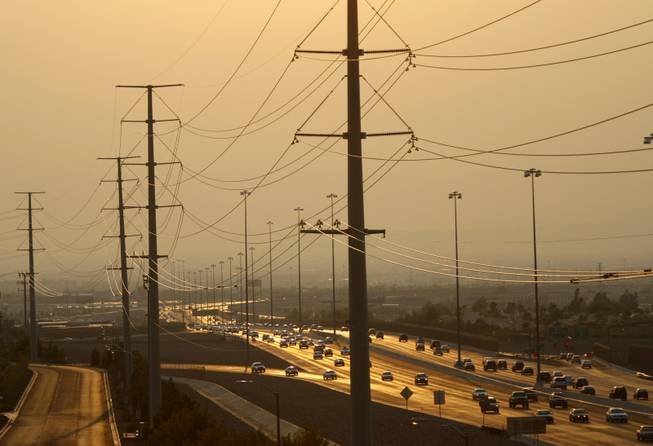
Smoke from California wildfires makes for a smoky commute on the I-215 Monday afternoon in Henderson, Aug. 31, 2009.
Wednesday, Sept. 2, 2009 | 2 a.m.
WHAT’S IN THE HAZE
The smoke in Las Vegas this week likely contains carbon dioxide, carbon monoxide, water vapor, nitrogen oxide, fine carbon soot, hydrocarbons and other organic compounds, plus a few trace minerals, a county official says. A more complete analysis will be able to pinpoint what actually burned — the proportion of grass, shrubs and trees — and even identify the types of trees.
IS IT HARMFUL?
It’s the fine particles in the smoke that could cause health problems, but air quality averages so far this week have been moderate by Environmental Protection Agency standards, a county official says.
WHEN WILL IT BE GONE?
Wind from a hurricane approaching Baja California could blow the smoke out of Las Vegas by Thursday. Rainfall, if it were predicted, would wash the smoke away more quickly.
Sun weather coverage
Sun Coverage
Beyond the Sun
- Centers of Disease Control and Prevention: Wildfires Fact Sheet
- Los Angeles Times: Wildfire coverage
- The Salt Lake Tribune: Yes, that gunk in the air is from wildfires (9-1-2009)
In many ways, Las Vegas is the easternmost major city of Southern California. We get the largest chunk of our tourists and new residents from there. When Southern California’s economy catches a cold, Las Vegas gets pneumonia. And when Southern California burns, we choke.
For three days (and maybe a fourth today), Las Vegas has been blanketed in a London-lite fog — and just like the famous clouds of long-ago London, it’s not fog but smoke. In London, the smoke came from the burning of soft coal. For us, the smoke comes from the burning of the hills above Pasadena and Glendale.
For three days, mountains have mostly disappeared and the Strip has been obscured by a gray veil. The smoke coats the tongue and parches the throat. At night, it blots out the few stars that usually dot our night. The smoke turns the moon to a shimmering orange.
The good news about the smoke is that it does not contain large particles of soot and ash (although, large is a relative term for objects that start at 10 micrometers, or one-seventh the thickness of the average human hair). However, the bad news is the smoke is composed of small particles, which are much easier to inhale deep into your lungs and are more likely to cause health problems.
The good news about the bad news is that so far the fine particle pollution (2.5 micrometers and finer — less than one thirtieth of a human hair) is only moderate. John Koswan, an assistant planning manager with Clark County’s Air Quality and Environmental Management Division, specializes in particulate matter and said that 24-hour-average concentrations in the valley have been on the high end of “moderate” on the EPA’s air pollution scale. That means they can be dangerous to children and the elderly with health problems, but only if they’re very active outdoors.
Koswan was coughing as he said it. Allergies, he said. The smoke is making them worse.
So what exactly are we choking on in a completely non-worrying way? It’s hard to say, Koswan said. The exact makeup of the particulate matter won’t be known until the material collected by five filters around the valley is packed off to a laboratory and analyzed in “a slow and tedious process.” It will take a couple of months.
But in general terms, Koswan said, the smoke is mostly carbon dioxide, carbon monoxide, water vapor, nitrogen oxide, fine carbon soot, hydrocarbons and other organic compounds, plus a few trace minerals. The finer analysis will be able to give us a better idea how much of the fire was grass, shrubs or trees — even what types of trees burned. Hardwoods and pines, for instance, give off very different smoke. And not all of the compounds released by the fire will be the same ones that arrive — they will react in the air with other molecules, including water vapor and air pollution.
(Incidentally, you can check the levels of air pollution in your neighborhood online at ccairquality.org.)
Phillip Wiker, the division’s meteorologist, said that with luck, the smoke should blow out of Las Vegas on Thursday, driven away by the winds of Hurricane Jimena as it spreads over Baja California.
But what if that doesn’t happen? we asked. What if, in contradiction to the general behavior of the Earth’s atmosphere, there was no kind of wind whatsoever to blow the smoke away? How long would this irritating, choking haze last?
Another three or four days, Wiker said. It’s a very fine suspension. It doesn’t just fall away.
Oh. Well, what if it rains?
The air would clear up right away, Wiker said.


Join the Discussion:
Check this out for a full explanation of our conversion to the LiveFyre commenting system and instructions on how to sign up for an account.
Full comments policy